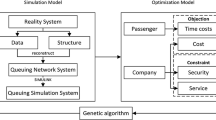Abstract
The remain passenger problem at subway station platform was defined initially, and the period variation of remain passenger queues at platform was investigated through arriving and boarding analyses. Taking remain passenger queues at platform as dynamic stochastic process, a new probabilistic queuing method was developed based on probabilistic theory and discrete time Markov chain theory. This model can calculate remain passenger queues while considering different directions. Considering the stable or variable train arriving period and different platform crossing types, a series of model deformation research was carried out. The probabilistic approach allows to capture the cyclic behavior of queues, measures the uncertainty of a queue state prediction by computing the evolution of its probability in time, and gives any temporal distribution of the arrivals. Compared with the actual data, the deviation of experimental results is less than 20%, which shows the efficiency of probabilistic approach clearly.
Similar content being viewed by others
References
ABRIL M, BARBER F, INGOLOTTI L, SALIDO M A, TORMOS P, LOVA A. An assessment of railway capacity [J]. Transportation Research Part E: Logistics and Transportation Review, 2008, 44(5): 774–806.
MILTOS K, ROBIN H, AMAB M. Metro railway safety: An analysis of accident precursors [J]. Safety Science, 2012, 50(7): 1535–1548.
ERAN B, DICK E. Rewarding rush-hour avoidance: A study of commuters’ travel behavior [J]. Transportation Research Part A, 2011, 45(7): 567–582.
BAYSARI M, MCINTOSH A S, WILSON J R. Understanding the human factors contribution to railway accidents and incidents in Australia [J]. Accident Analysis and Prevention, 2008, 40(5): 1750–1757.
SHI Cong-ling, ZHONG Mao-hua, NONG Xing-zhong, HE Li, SHI Jie-hong, FENG Guo-guan. Modeling and safety strategy of passenger evacuation in a metro station in China [J]. Safety Science, 2012, 50(5): 1319–1332.
ZHANG Qi, HAN Bao-ming. Modeling and simulation of passenger alighting and boarding movement in Beijing metro stations [J]. Transportation Research Part C, 2008, 16(5): 635–649.
WILLIAM H K, CHEUNG Chung-yu. A study of crowding effects at the Hong Kong light rail transit stations [J]. Transportation Research Part A, 1999, 33(5): 401–415.
DAAMEN W, HOOGENDOORN S P. Research on pedestrian traffic flows in the Netherlands [C]// Proceedings Walk 21 IV, Portland, USA: Walk 21 Conference, 2003: 101–117.
HARRIS N G, ANDERSON R J. An international comparison of urban rail boarding and alighting rates [J]. Proceedings of the Institution of Mechanical Engineers Par t F: J. Rail and Rapid Transit, 2006, 221(4): 521–526.
CAO Shou-hua, YUAN Zhen-zhou. Characteristics analysis and model establishment for passenger boarding time in urban rail transit [J]. Journal of the China Railway Society, 2009, 31(3): 89–93 (in Chinese).
ÖZGÜR Y, MIRAC G. Modeling and optimization of average travel time for a metro line by simulation and response surface methodology [J]. European Journal of Operational Research, 2009, 196(1): 225–233
RODRIGO F. Modeling public transport stops by microscopic simulation [J]. Transportation Research Part C: Emerging Technologies, 2010, 18(6): 856–868.
CATLING I. A time dependent approach to junction delays [J]. Traffic Engineering and Control, 1977, 18(11): 520–526.
MIHO A, TAKAMASA I, MASAO K. Microscopic pedestrian simulation model combined with a tactical model for route choice behavior [J]. Transportation Research Part C, 2010, 18(6): 842–855.
GB50157-2003. Code for design of Metro. [S]
Author information
Authors and Affiliations
Corresponding author
Additional information
Foundation item: Project(2011BAG01B01) supported by the Major State Basic Research and Development Program of China; Project(RCS2012ZZ002) supported by the State Key Lab of Rail Traffic Control and Safety, China
Rights and permissions
About this article
Cite this article
Xu, Xy., Liu, J., Li, Hy. et al. Probabilistic model for remain passenger queues at subway station platform. J. Cent. South Univ. 20, 837–844 (2013). https://doi.org/10.1007/s11771-013-1555-2
Received:
Accepted:
Published:
Issue Date:
DOI: https://doi.org/10.1007/s11771-013-1555-2




